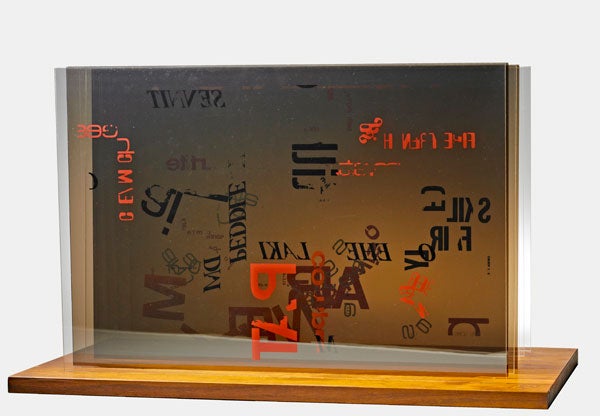|
June 27, 2012
See John Cage's plexigrams at Stanford's Cantor Arts Center and hear his music in Campbell Recital Hall
In this centennial year of John Cage's birth, four of the artist's first graphic works are on display. This fall, Stanford also will host a two-day festival of the groundbreaking composer's music. By Robin Wander

John Cage, 'Not Wanting to Say Anything About Marcel' (Photo: Courtesy of the Cantor Arts Center)
Contemporary composer John Cage is perhaps best known for a musical score that is silent. The piece, "4'33"," challenged conventional wisdom about what was music – sounds made or listened to? The composition was just one of the many ways Cage, who died in 1992, ended up influencing contemporary classical music and pushing the boundaries of what defines art.
Cage, who was also a visual artist, writer and performance collaborator, would have been 100 next September. The centennial year of his birth is being celebrated with performances, festivals and exhibits all over the world, including at Stanford.
Not Wanting to Say Anything About Marcel: John Cage Plexigrams is on view at the Cantor Arts Center through Nov. 11. Stanford's Department of Music also is presenting Cage concerts on Oct. 11 and 12, with a panel discussion featuring four of Cage's collaborators on the second night.
In 1969, Cage created a series of eight "plexigrams" collectively titled "Not Wanting to Say Anything about Marcel" to honor his good friend and fellow artist Marcel Duchamp, who died in 1968.
The title of the works refers to a comment Jasper Johns made to Cage when artists were encouraged to respond in memoriam to Duchamp's death. Johns said, in effect, that he didn't want to say anything, and Cage used this for his title.
In 1973, Stanford acquired four of the eight constructions in the series as a gift from John and Nancy Merryman.
Seeing Cage
While Cage was the composer-in-residence at the University of Cincinnati, he made his first foray into the visual arts by creating the plexigram series at nearby Eye Editions.
Each of the eight constructions, produced in an edition of 125, consists of six clear and two tinted Plexiglas panels silkscreened with images and seemingly random typography, set on edge in a slotted wooden base.
Separately, the panels are transparent sheets; even the bronze tinted sheets are not completely opaque. But when viewed as a layered whole, the floating pictures and broken words create a new three-dimensional object.
Cage determined the content as well as the color and placement by a group of chance outcomes obtained from the Chinese I Ching system. He intended for the works to be installed with regard to chance, with the panels in a different order each time the plexigrams were displayed.
Patience Young, the curator for education at the Cantor, organized the exhibition and supervised the installation in keeping with Cage's adherence to chance.
"The gallery has been kept spare and neutral to allow viewers to examine these constructions as fully and clearly as possible," said Young. "Visitors will find them to be surprising and mysterious, silent yet evocative of acoustic incidents of all types."
The constructions are significant because they represent the artist's first exploration of visual media corresponding to his ongoing exploration of sound and music. Chance plays a part in Cage's visual art and music composition.
"Bring an open mind for aesthetic adventure, and allow some time to absorb the subtle riches to be found in this little gallery," advised Young.
Hearing Cage
Thomas Schultz, senior lecturer in Stanford's Department of Music, initially approached Young about a collaboration to celebrate the Cage centennial.
"I am much interested in Cage's use of chance procedures and indeterminacy in music and also with his work in the visual arts," said Schultz, who teaches piano. Thus, the plexigrams and the festival seemed a fitting duet.
Schultz has organized two concerts and a panel discussion for the commemorative festival John Cage – 100 Years at Stanford's Campbell Recital Hall.
"My interest in Cage was initially an interest in his piano music and, of course, the pieces for prepared piano," said Schultz. A prepared piano, made famous by Cage, is one that has been altered by placing objects on or between the strings to create new sounds. "This grew to an enjoyment of his music for percussion ensemble, his chamber and orchestral music, his writing for voice and more unusual instruments such as sea shells and cactus parts, and also his work with electronic music, usually in collaboration with other composers."
For the centennial, Schultz has planned concerts of Cage's music with music of composers whose work is related in some way to Cage. Schultz has also invited four people who knew Cage personally and worked directly with him to participate in a panel discussion of Cage and his work that will precede the festival's second concert.
The first concert on Oct. 11 features works for solo piano by Cage, Hyo-shin Na, Morton Feldman, Frederic Rzewski, Christian Wolff and Walter Zimmermann, with Schultz on piano. The concert begins at 8 p.m.
The second night of the festival beings with a panel discussion at 7 p.m. Panelists are Wolff, composer, colleague of Cage, New York School composer and retired professor of classics at Dartmouth College; Zimmermann, composer, colleague of Cage and professor of composition at Hochschule der Künste in Berlin; Kathan Brown, the founder and director of Crown Point Press in San Francisco, where she collaborated with Cage in the making of his visual art; and Laura Kuhn, the director of the John Cage Trust at Bard College in Red Hook, N.Y.
The Oct. 12 concert following the panel discussion starts at 8 p.m. and includes chamber works by Cage, Wolff, Zimmermann and Anton Webern. Schultz is on piano accompanied by James Fulkerson, trombone; Geoff Nuttall, violin; and the Wooden Fish Ensemble with Stan Poplin, double bass; Mark Veregge, percussion; Shoko Hikage, koto; and Hyun-young Choi, kayageum.
-30-
|